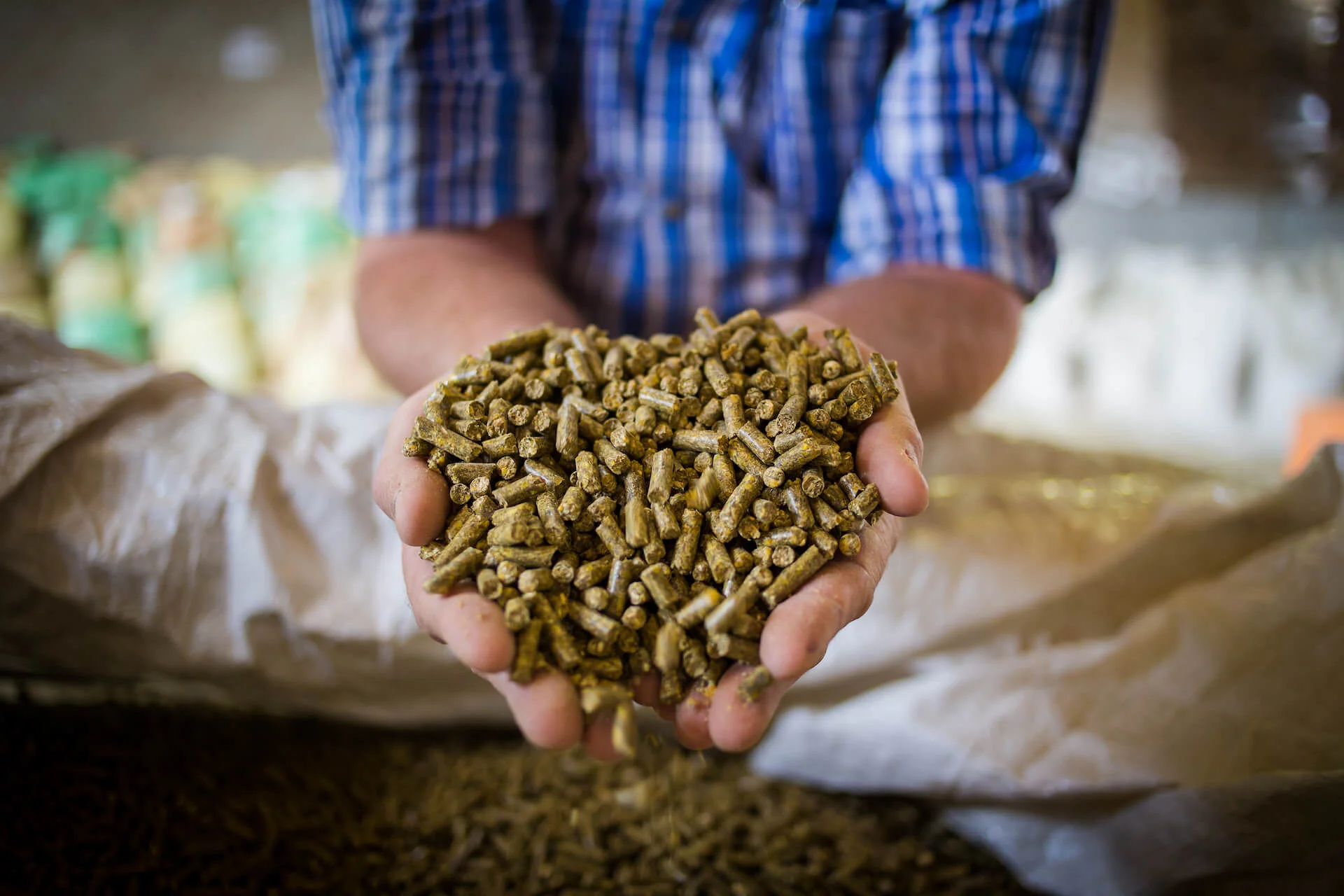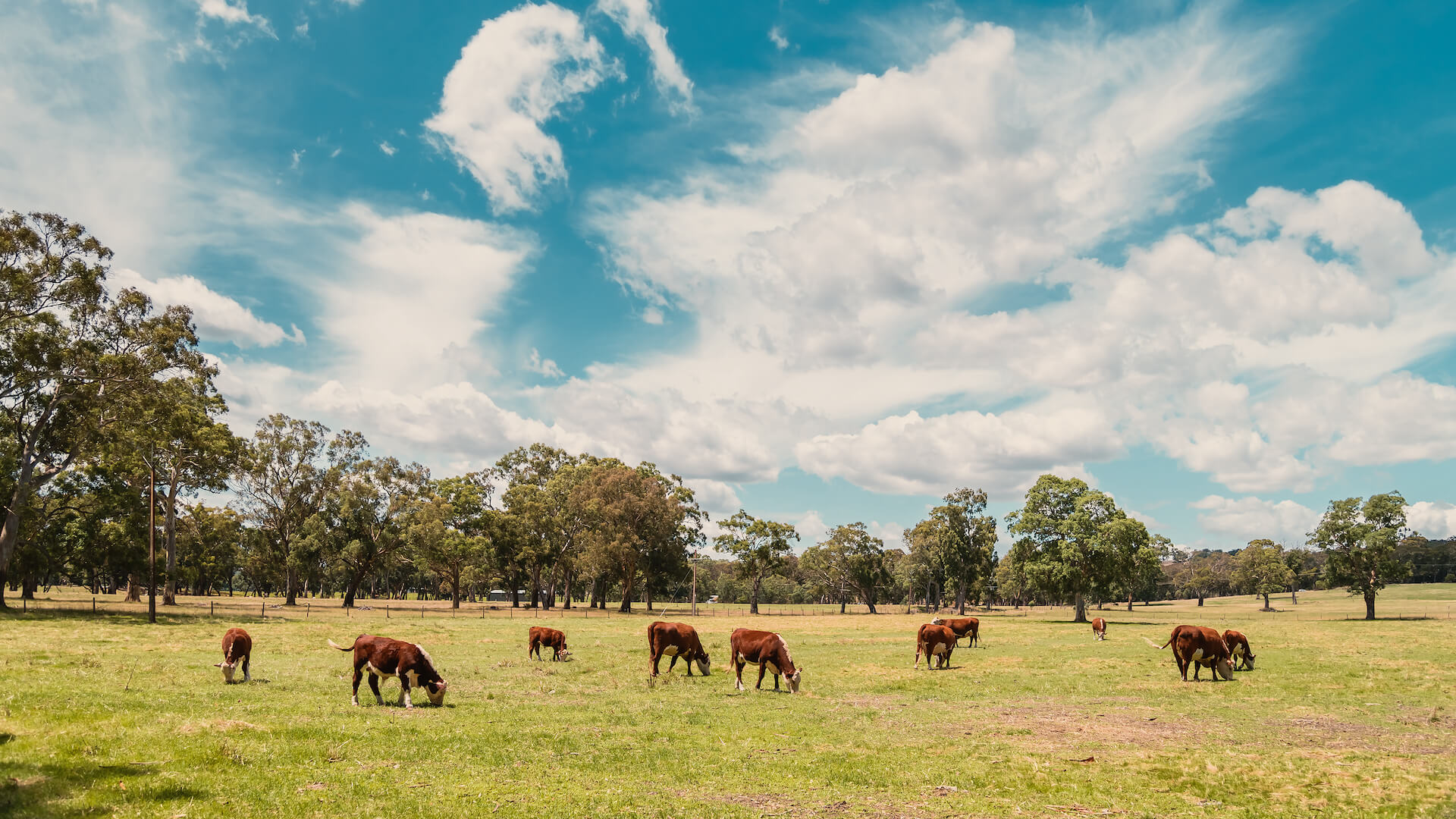Organic animal feed has been grown without added synthetic pesticides, herbicides, or fertilisers. Genetically Modified Organisms (GMOs) are not allowed within organic systems, neither are a number of other growth promotants such as hormones and antibiotics.
When you buy organic animal feed, you are choosing a safe, nutritious product for your animal and are promoting the holistic organic system it represents. Adding synthetic nitrogen has higher chances of eutrophication and greenhouse gas emissions[1]. Fast release synthetic nitrogen fertilisers may also increase pest pressure[2], leading to increased use of pesticides in fields and for grain production. Within organic livestock systems, beneficial legumes such as clover and vetch are used as cover crops to fix nitrogen from the atmosphere for the soil, rather than adding in synthetic nitrogen.
Around 80% of the beef available in Australian supermarkets could be from feedlots, rather than from free ranging animals that have access to pasture all their lives[3]. Most organic cattle and sheep are completely grass fed with minimal feeding unless in periods of drought. Organic poultry and pork have access to pasture and are fed organic grain mixes to complement production. The practice of feedlots is also typically accompanied with increased antibiotic use, and the use of hormone growth promotants (HGPs)[4].

Shockingly, over 75% of the world’s antibiotics are used in livestock production[14], largely as a substitute for good nutrition and hygiene[8]. Antibiotics are used to both treat infections and can act as a growth promotant when used in low doses. Antibiotics are not allowed within organic production as they destroy gut bacteria and promote unnatural growth[9]. If an organic animal is treated with antibiotics or consumes feed containing antibiotics, it renders them no longer organic. Subtherapeutic concentrations of antibiotics in animal feed increase livestock growth by 10-20%, however also promote antibiotic resistance, leave residues in meat[10] and may not be economically profitable for the farmer[11].
Beef feedlot conditions have been shown to encourage antibiotic resistant bacteria. These bacteria can then readily transfer to farmland soils surrounding the feedlot, with the potential to adversely affect human and animal health. A study by the University of New England found that fresh feedlot manure contained high populations of antibiotic-resistant bacteria which alarmingly remained in the soils that were treated with that same manure[12].

You may be wondering why there is a price difference between non-organic and organic animal feed. The first reason is that organic producers pay additional certification and audit fees to become certified organic and prove that they adhere to stringent organic standards. Organic producers are then audited annually to ensure they maintain these standards. And it’s not just the producers who become certified. The whole supply chain from the soil to the animal’s mouth is also verified to ensure the end product remains certified organic.
Secondly, the organic grain that may be required to supplement the diets of organic livestock can also cost more. Since there are no synthetic chemicals used in organic grain production, the crops often experience increased weed competition, and pest and disease pressure. This may cause yield losses and therefore increase the cost of production. This cost is then passed down through the supply chain, resulting in a more expensive end product.

Organic certification encompasses the entire lifecycle of plants and animals. When you buy certified organic animal feed, you can rest assured that it is quality feed, free from GMOs, hormones, antibiotics and excessive synthetic pesticide residues.
[1] Chai, R., Ye, X., Ma, C. et al. (2019) Greenhouse gas emissions from synthetic nitrogen manufacture and fertilization for main upland crops in China. Carbon Balance Manage 14, 20.https://doi.org/10.1186/s13021-019-0133-9.
[2] Buckland K, Reeve JR, Alston D, Nischwitz C & Drost D (2013) Effects of nitrogen fertility and crop rotation on onion growth and yield, thrips densities, Iris yellow spot virus and soil properties. Agriculture, Ecosystems & Environment 177: 63–74.
[3] Available at: https://futurebeef.com.au/knowledgecentre/feedlots/#:~:text=Approximately%2040%25%20of%20Australia’s%20total,to%20over%20100%20international%20markets.
[4] Gaughan JB, Kreikemeier WM, Mader TL (2005) Hormonal growth-promotant effects on grain-fed cattle under different environments. International Journal of Biometeorology 49, 396–402. doi:10.1007/s00484-005-0254-6Gorman.
[5] Lean, Ian. (2013). Effects of retailer pressure on the efficiency of agricultural industries. Animal Production Science. 53. 1143. 10.1071/AN13178.
[6] Hunter A (2010) Hormonal growth promotant use in the Australian beef industry. Animal Production Science 50, 637–659. doi:10.1071/AN09120Kastner.
[7] Watson RA (2008) Meta-analysis of the published effects of HGP use on beef palatability in steers as measured by objective and sensory testing. Australian Journal of Experimental Agriculture 48, 1425–1433.doi:10.1071/EA07174FAnimal Production Science I. J. Lean www.publish.csiro.au/journals/an.
[8] Van Boeckel, T.P., Glennon, E.E., Chen, D., Gilbert, M., Robinson, T.P., Grenfell, B.T., Levin, S.A., Bonhoeffer, S. and Laxminarayan, R., 2017. Reducing antimicrobial use in food animals. Science, 357(6358), pp.1350-1352.
[9] Collier, H. R., & Anderson C.T. (2006). Antibiotics As Growth Promotants: Mode of Action. Animal Biotechnology 13 (1), p. 13. Retrieved from: http://nla.gov.au/nla.news-article131650786.
[10] World Health Organisation (2018). Antimicrobial resistance in the food chain. [Fact Sheet] Retrieved from: https://www.who.int/news-room/fact-sheets/detail/antimicrobial-resistance.
[11] Graham, J. P., Boland, J. J., & Silbergeld, E. (2007). Growth promoting antibiotics in food animal production: an economic analysis. Public health reports (Washington, D.C. : 1974), 122(1), 79–87. https://doi.org/10.1177/003335490712200111.
[12] UNE 2022 https://www.une.edu.au/connect/news/2022/01/feedlots-may-be-contributing-to-antibiotic-resistance.
[13] Van Eenennaam, A.L. (2013) GMOs in animal agriculture: time to consider both costs and benefits in regulatory evaluations. J Animal Sci Biotechnol 4, 37. https://doi.org/10.1186/2049-1891-4-37.
[14] World Health Organisation (2020). Antibiotic resistance [Web Page] Retrieved from: https://www.who.int/news-room/fact-sheets/detail/antibiotic-resistance.
Australian Organic Limited (AOL) is the peak body for the organic industry.
AOL acknowledges the Traditional Custodians of the land on which we operate, the Turrbal and Yuggera people. We extend our respect to Elders past, present and emerging.